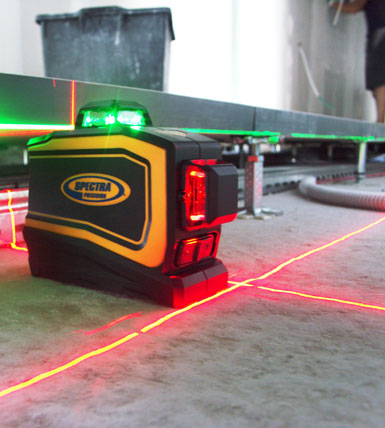Line Lasers – Everything You Need To Know
Line Lasers are a staple of the construction trade, every Internal Fit Out Contractor will have one, every Electrician will have one, every Carpenter, Tiler, Commercial Plumber and Gyprocker’s. This means there is a lot of Line Lasers on the market all offering what seemingly is different specs, options, abilities and functionality.
This article will breakdown the things to keep an eye on when it comes to looking at Line Lasers making sure the conform to the Australian Safety Standards and the ins and outs of Line Lasers in general.
When it comes to Line Lasers the first thing you need to know is the gradients of difference between your $1000+ Line Lasers and your cheap $200 Line Lasers.
Other than build quality differences which cover things such as, Laser Accuracy, Drop Protection, IP Ratings and Compactness there are also other various differences which make up the differences between Cheaper Line lasers and more Expensive Line Lasers.
The biggest and notable difference in line lasers is the amount of lines they generate. Some are standard front Cross Line lasers producing just a Horizontal & Vertical Line from the front of the laser, others have a complete 360 Degree Horizontal & Vertical Line display allowing you to setup once and translate levels from one side of the room to the other without moving the laser at all.
Differences between Cheap & Expensive Line Lasers
When it comes to purchasing a line laser there are plenty on the market and they al look very similar to one another. Before you make your purchase we will highlight some things to look out for and ask your local sales person as to whether or not the laser you are looking at comes with or can do these particular things.
Accuracy over 10 Meters – Usually a cheap laser which isn’t built to the standard of the higher end manufacturers will either not display their accuracy or change it to 5 Meters or a different metric of displaying it. They do this to try and confuse you when it comes to purchasing. A good laser level will have an accuracy of 2mm – 3mm @ 10M depending on the type of laser level it is. Where as a cheaper one will generally say 2.5mm @ 5M, if you extend this out to 10M you will find it is infact 5mm @ 10M which is not accurate enough for most internal trades.
Water & Dust Proof – Cheaper Line Lasers will generally say they are either IP46 or IP54 Rated. What this rating means refers to the is explained in our article – “What do IP Ratings Mean” but in short
IP46 is NOT Dust Proof but can withstand water jets for about 1 minute.
IP54 is Dust Protected but can only protect itself from Splashes of Water.
Why is this important? Knowing what your Line Laser is capable of withstanding allows you to use it effectively and get the longest use out of your investment. When it comes to cheaper Line Lasers you will find the level of protection of is lower than your more expensive Line Lasers.
Number of Lines – Another aspect of difference between Cheaper and Higher Quality line lasers is the number of lines generated from the laser itself. From front cross lines to 360 Degree Horizontal & Vertical there are many differences between different models and that causes the price of each unit to vary.
Most cheaper line lasers will only produce minimal lines for you to use, this allows the manufacture to keep the price down as much as possible. The problem this causes is it requires you as the operator to move the laser around and relevel yourself which can cause errors.
Having a more expensive laser level which produces 360 Degree Lines this allows you to setup once and not have to move the laser during the job. This saves on time and errors that may be cause by moving your bench to a different location. It also allows you to set your laser in a single known location to avoid it being knocked over by anyone else on site saving it from potential damage.
Calibration Ability – The final technical piece of information that sets cheaper and more reliable Line Lasers apart is the ability for the them to be recalibrated after 6 months. For all Line & Rotating lasers a 6 monthly calibration is recommended. This is because with constant use all Lasers will eventually move out of calibration and be required to be put back in calibration.
What you will find with the cheaper ones is they are actually not able to be re-calibrated, this is due to their housing being completely sealed and the compensator inside the unit being a simple system which does not allow adjustments to occur. In this instances with Cheaper Line Lasers you will find that a new one must be purchased if the Line Laser is to far out of calibration range. This can be an expensive process if you are constantly replacing Line Lasers every 6 – 18 months.
Whereas with your more expensive and trusted Line Lasers these are infact calibratable which will help extend their lifespan and usefulness to you. So spending a bit more on a quality product will give you 3 – 10 years life out of the Laser vs 6 – 18 months.
If you are wondering how often you should be getting your Laser Level or Line Laser calibrated read our article – “When should i calibrate my laser” and learn how often and were you can send in your laser to get some much needed TLC.

